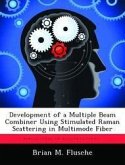This thesis tested a CW fiber-based Raman amplifier implemented in a backward pumped geometry. To create a seed for the amplifier, a CW Nd:YAG laser operating at 1.064??m was used to pump a 50??m multimode graded index fiber using fiber Bragg gratings to create a Raman Fiber Laser (RFL) Oscillator with a Stokes beam at 1.116??. The Stokes beam was then used to seed two lengths, 5.3km and 2.5km, of 50?? multimode graded index fiber. The fiber amplifier was pumped by a second CW Nd:YAG laser in the backward geometry. Spectral data taken for both fibers indicated that the backward geometry avoided the problem of Four Wave Mixing (FWM) present in the forward geometry for amplification. Gain and beam cleanup were observed in both lengths of fiber. An M2 of 6.7 0.2 was observed in the 5.3km fiber with 5 W of pumping. With 9 W of pump, a gain of 321.3% was observed, but severe attenuation due to the length of fiber prevented overall amplification of the seed with the available pump power. The 2.5km fiber produced an M2 of 3.9 0.5 with 5 W of pumping. With 10 W of pump, a gain of 241.8% and overall amplification of 153.1% was observed.








